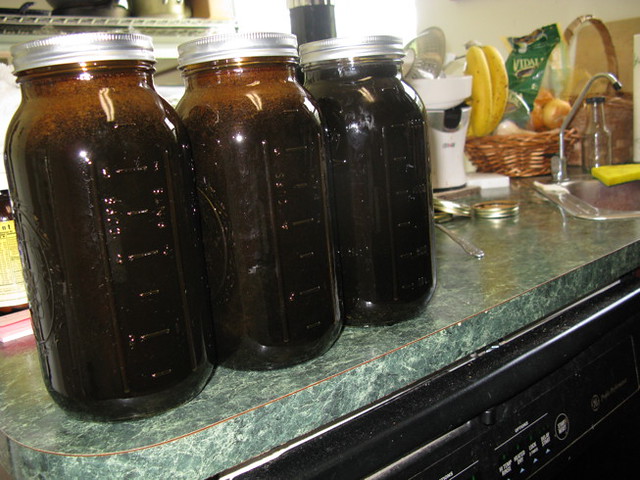As well as being good for humans (I eat a Tbsp daily in my oatmeal), blackstrap is used as a food for microorganisms in the production of compost tea. A few years ago when I had a large garden and was making lots of compost tea I bought a five-gallon bucket of blackstrap. I needed more (both for consumption and for tea), as did my son who makes lots of compost tea for his garden, so we went together and bought another five-gallon bucket. We did the numbers and discovered we paid less than a third the price of blackstrap sold by the pint or quart bottle in grocery stores. The molasses is unsulphured, produced by the Amish in Pennsylvania, and purchased from The Grain Mill of Wake Forest here in NC.
We split the five gallons, so I had 2.5 gallons to store. I vacuum-sealed 1.5 gallons in three half-gallon Ball canning jars using my FoodSaver vacuum sealer: (Since blackstrap is a liquid, you could fill the jar to very top, thus eliminating almost all the air. Oxygen is the great destroyer of food -- it's why vegetables have skins -- to keep the cells from oxidizing by coming in contact with air. One of the main ways I'm using vacuum sealing is for preserving the enzymatic activity in fresh-juiced vegetable juices, stored in 8-oz. Ball jars, for 2-3 days at a time after juicing. So I'm beginning to learn how to vacuum seal food in an experimental sort of way.)
I'll store these jars in the back of the refrigerator just to keep them cool: (You can see in the first two jars how the vacuum in the top half-inch of the jars is pulling TINY air bubbles out of the molasses toward the vacuum. I may try unsealing these in a few days and re-sealing them in an attempt to pull out even more oxygen. A little OCD there, but experimenting is part of learning.)
And I used an empty maple syrup container to store enough on the pantry shelf for daily use:
And the small remainder stayed in the food-safe five-gallon container to be used for compost tea this summer.








No comments:
Post a Comment